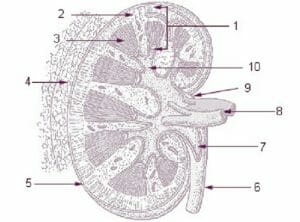Parenchyma Definition
Parenchyma is a term used to describe the functional tissues in plants and animals. This tissue is “functional” – performing tasks such as photosynthesis in plants or storing information in the human brain – as opposed to “structural” tissues like wood in plants or bone in animals.
In plants, parenchyma refers to a specific type of ground tissue with thin cell walls and the ability to grow and divide.
Parenchyma makes up most of the cells within leaves, flowers, and fruits. Hard, structural features such as bark, outer coverings, and major veins in these structures are “structural” rather than “parenchymal” tissue.
In healthy animals, “parenchyma” is much more varied. It refers to the cells that perform the biological function of the organ – such as lung cells that perform gas exchange, liver cells that clean blood, or brain cells that perform the functions of the brain.
In the diagram below, the tissues designated by the number “1” are parenchymal tissues of the kidney.
You will notice that “1” designates the tissues of the kidney that perform the function of blood filtration, excluding only the protective membranes and the fluid-carrying vessels serve to direct blood and urine in and out of the kidney.
Another definition of “parenchyma” is a definition applied to cancer and other growths. When discussing growths, the “parenchyma” is the pathological tissue of the growth which is capable of growing and reproducing.
The last definition of “parenchyma” refers to the spongy, connective tissue in certain invertebrates such as flatworms. In most animals, connective tissues are not considered “parenchyma,” but because some simple invertebrates do not have highly differentiated tissues, their connective tissue may also be parenchymal.
The word “parenchyma” comes from a Greek word for “to pour in” or “to fill,” representing the idea that parenchymal cells usually refer to the bulk of functional tissues in a plant or animal.
In the same way that “functional” tissues of plants and organs are called “parenchyma,” “structural” tissues in plants, animals, and growths are sometimes called “stroma.”
Function of Parenchyma
Because “parenchyma” is an umbrella term for all cells that perform non-structural biological functions, the functions of parenchymal cells are many. Here are a few.
In plants, parenchymal cells with thin cell walls and the ability to reproduce fulfill functions including:
- Photosynthesis
- Gas exchange
- Food storage
- Wound repair and new growth
- Secretion of sap
- Other specialized functions in certain plants, such as buoyancy control in aquatic plants.
In animals, “parenchymal” cells refer to the functional cells in every organ. That means that almost every function performed in an animal’s body is performed by parenchymal cells. There are too many of these functions to count in total, but some examples are:
- Perception, thinking, information storage and processing (nervous system)
- Gas exchange (lungs)
- Producing immune cells (lymphatic system)
- Secreting hormones (pancreas, various reproductive organs, brains, adrenal glands)
- Filtering blood (kidneys)
- Breaking down toxins (liver)
And many more!
Types of Parenchyma
The term “parenchyma” has been used to describe several different types of plant and animal tissues. Here are the most common uses of the word “parenchyma.”
Plant Parenchyma
In plants, “parenchyma” refers to a distinct tissue type that has thin cell walls and the ability to grow and divide.
Plant parenchyma cells make up the bulk of leaves, flowers, and the growing, dividing inner parts of stems and roots.
They perform functions such as photosynthesis, food storage, sap secretion, and gas exchange.
Organ Parenchyma
In animals, the bulk of functional cells in any organ is called the “parenchyma.” This distinguishes the cells which perform the organ’s primary function from “structural” cells that serve mainly to protect or give form to the parenchyma.
That means that virtually all functions performed within an animal’s body, except for structural and protective functions, are performed by parenchymal cells.
Examples of “structural” cells in animals include the hard, calcified cells in bones and the protective membranes around most organs.
Tumor Parenchyma
When talking about cancer or other growths, the term “functional” is again useful for discussing parenchyma.
The parenchyma of a tumor or other growth is considered to be the “neoplastic” part which is capable of cell division.
This allows the parenchyma to serve the pathological “function” of allowing the tumor to keep spreading and growing.
Invertebrate Parenchyma
The term “parenchyma” has sometimes been used to describe the spongy, connective tissues of invertebrates such as flatworms.
In other animals, connective tissue is not normally considered to be parenchyma.
Quiz
1. Which of the following is NOT made up mostly of parenchymal tissue?
A. The leaves of a tree
B. A kidney
C. A large cancerous tumor
D. Tree bark
2. What might be one reason for having multiple definitions of the term “parenchyma?”
A. Scientists are easily confused and imprecise with their language.
B. Scientists began using the term when tissue types were described based on superficial similarities, and attempts were made to draw similarities between tissue types in different living organisms.
C. Scientists from one discipline sometimes “borrow” terms that were originally developed by another discipline to describe a similar concept in their own field.
D. B & C
3. Which of the following organisms would you NOT expect to have parenchymal cells?
A. Tree
B. Daisy
C. Bacteria
D. Human
References
- LeMone, P., Burke, K., Dwyer, T., Levett-Jones, T., Moxham, L., Reid-Searle, K., . . . Raymond, D. (2013). Medical-Surgical Nursing. Pearson Australia.
- Kufe, D. W., Holland, J. F., & Frei, E. (2006). Holland-Frei cancer medicine 7. Hamilton, Ont.: BC Decker.
- Parenchyma. (n.d.). Retrieved May 26, 2017, from http://www.dictionary.com/browse/parenchyma

